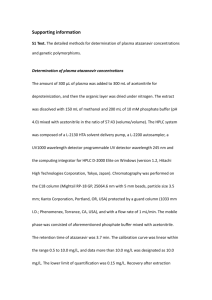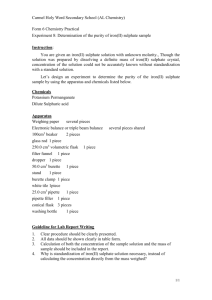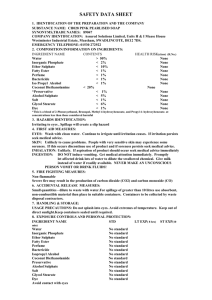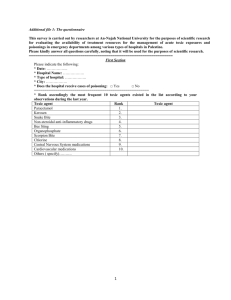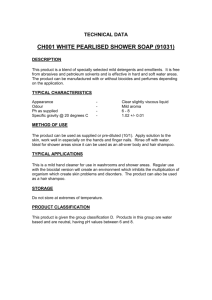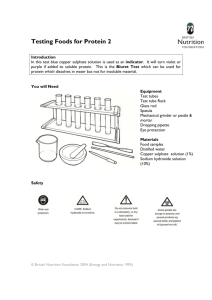Document 13310844
advertisement
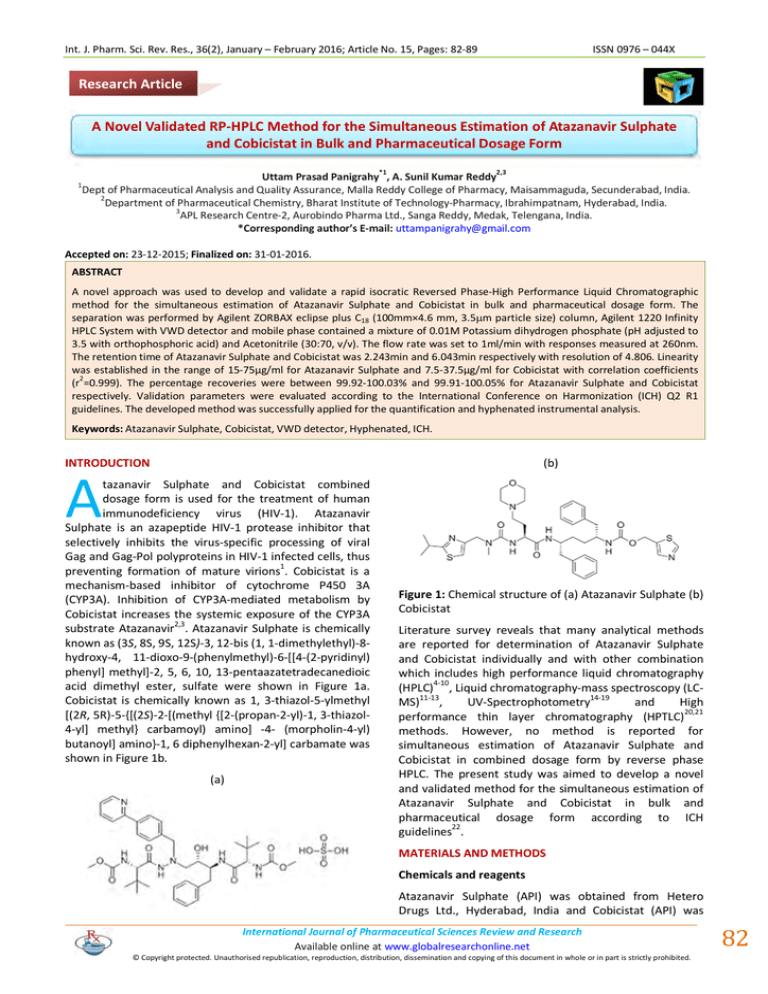
Int. J. Pharm. Sci. Rev. Res., 36(2), January – February 2016; Article No. 15, Pages: 82-89
ISSN 0976 – 044X
Research Article
A Novel Validated RP-HPLC Method for the Simultaneous Estimation of Atazanavir Sulphate
and Cobicistat in Bulk and Pharmaceutical Dosage Form
1
Uttam Prasad Panigrahy*1, A. Sunil Kumar Reddy2,3
Dept of Pharmaceutical Analysis and Quality Assurance, Malla Reddy College of Pharmacy, Maisammaguda, Secunderabad, India.
2
Department of Pharmaceutical Chemistry, Bharat Institute of Technology-Pharmacy, Ibrahimpatnam, Hyderabad, India.
3
APL Research Centre-2, Aurobindo Pharma Ltd., Sanga Reddy, Medak, Telengana, India.
*Corresponding author’s E-mail: uttampanigrahy@gmail.com
Accepted on: 23-12-2015; Finalized on: 31-01-2016.
ABSTRACT
A novel approach was used to develop and validate a rapid isocratic Reversed Phase-High Performance Liquid Chromatographic
method for the simultaneous estimation of Atazanavir Sulphate and Cobicistat in bulk and pharmaceutical dosage form. The
separation was performed by Agilent ZORBAX eclipse plus C18 (100mm×4.6 mm, 3.5m particle size) column, Agilent 1220 Infinity
HPLC System with VWD detector and mobile phase contained a mixture of 0.01M Potassium dihydrogen phosphate (pH adjusted to
3.5 with orthophosphoric acid) and Acetonitrile (30:70, v/v). The flow rate was set to 1ml/min with responses measured at 260nm.
The retention time of Atazanavir Sulphate and Cobicistat was 2.243min and 6.043min respectively with resolution of 4.806. Linearity
was established in the range of 15-75µg/ml for Atazanavir Sulphate and 7.5-37.5µg/ml for Cobicistat with correlation coefficients
(r2=0.999). The percentage recoveries were between 99.92-100.03% and 99.91-100.05% for Atazanavir Sulphate and Cobicistat
respectively. Validation parameters were evaluated according to the International Conference on Harmonization (ICH) Q2 R1
guidelines. The developed method was successfully applied for the quantification and hyphenated instrumental analysis.
Keywords: Atazanavir Sulphate, Cobicistat, VWD detector, Hyphenated, ICH.
INTRODUCTION
(b)
A
tazanavir Sulphate and Cobicistat combined
dosage form is used for the treatment of human
immunodeficiency virus (HIV-1). Atazanavir
Sulphate is an azapeptide HIV-1 protease inhibitor that
selectively inhibits the virus-specific processing of viral
Gag and Gag-Pol polyproteins in HIV-1 infected cells, thus
preventing formation of mature virions1. Cobicistat is a
mechanism-based inhibitor of cytochrome P450 3A
(CYP3A). Inhibition of CYP3A-mediated metabolism by
Cobicistat increases the systemic exposure of the CYP3A
2,3
substrate Atazanavir . Atazanavir Sulphate is chemically
known as (3S, 8S, 9S, 12S)-3, 12-bis (1, 1-dimethylethyl)-8hydroxy-4, 11-dioxo-9-(phenylmethyl)-6-[[4-(2-pyridinyl)
phenyl] methyl]-2, 5, 6, 10, 13-pentaazatetradecanedioic
acid dimethyl ester, sulfate were shown in Figure 1a.
Cobicistat is chemically known as 1, 3-thiazol-5-ylmethyl
[(2R, 5R)-5-{[(2S)-2-[(methyl {[2-(propan-2-yl)-1, 3-thiazol4-yl] methyl} carbamoyl) amino] -4- (morpholin-4-yl)
butanoyl] amino}-1, 6 diphenylhexan-2-yl] carbamate was
shown in Figure 1b.
(a)
Figure 1: Chemical structure of (a) Atazanavir Sulphate (b)
Cobicistat
Literature survey reveals that many analytical methods
are reported for determination of Atazanavir Sulphate
and Cobicistat individually and with other combination
which includes high performance liquid chromatography
(HPLC)4-10, Liquid chromatography-mass spectroscopy (LCMS)11-13,
UV-Spectrophotometry14-19
and
High
performance thin layer chromatography (HPTLC)20,21
methods. However, no method is reported for
simultaneous estimation of Atazanavir Sulphate and
Cobicistat in combined dosage form by reverse phase
HPLC. The present study was aimed to develop a novel
and validated method for the simultaneous estimation of
Atazanavir Sulphate and Cobicistat in bulk and
pharmaceutical dosage form according to ICH
guidelines22.
MATERIALS AND METHODS
Chemicals and reagents
Atazanavir Sulphate (API) was obtained from Hetero
Drugs Ltd., Hyderabad, India and Cobicistat (API) was
International Journal of Pharmaceutical Sciences Review and Research
Available online at www.globalresearchonline.net
© Copyright protected. Unauthorised republication, reproduction, distribution, dissemination and copying of this document in whole or in part is strictly prohibited.
82
Int. J. Pharm. Sci. Rev. Res., 36(2), January – February 2016; Article No. 15, Pages: 82-89
obtained from Shilpa Medicare Limited, India. HPLC grade
of Potassium dihydrogen phosphate was obtained from
Rankem Ltd., India and HPLC grade of Acetonitrile was
obtained from Merck Specialities Private Limited, India.
HPLC grade of Water and Ortho phosphoric acid was
obtained from Rankem Ltd., India. Evotaz tablet contains
300 mg of Atazanavir Sulphate and 150 mg of cobicistat
were kindly supplied by Bristol-Myers Squibb.
Selection of UV-wavelength
In simultaneous estimation of Atazanavir Sulphate and
Cobicistat isosbestic wavelength is used. Standard stock
solutions of Atazanavir Sulphate and Cobicistat were
prepared by dissolving 300mg of Atazanavir Sulphate and
150mg of Cobicistat in 100ml of diluent into a 100ml
clean dry volumetric flask and the standard solutions was
filtered through 0.45µm nylon membrane filter and
degassed by sonicator to get the concentration of
3000µg/ml of Atazanavir Sulphate and 1500µg/ml of
Cobicistat. From the above standard stock solution of
3000µg/ml of Atazanavir Sulphate and 1500µg/ml of
Cobicistat further pipette 10ml and transferred into a
100ml volumetric flask and dilute up to the mark with
diluent to get the concentration of 300µg/ml of
Atazanavir Sulphate and 150µg/ml of Cobicistat further
pipette 1ml and transferred into a 10ml volumetric flask
and dilute up to the mark with diluent to get the
concentration of 30µg/ml of Atazanavir Sulphate and
15µg/ml of Cobicistat. The wavelength of maximum
absorption (λmax) of 30µg/ml of Atazanavir Sulphate and
15µg/ml of Cobicistat were scanned using UV-Visible
spectrophotometer within the wavelength region of 200–
400 nm against mobile phase as blank. The isosbestic
wavelength (λmax) was found to be 260nm for the
combination shown in Figure 2.
ISSN 0976 – 044X
filter paper No. 41 (Whatmann International Ltd.,
England) were used in the study. Atazanavir Sulphate and
Cobicistat were analyzed in Agilent ZORBAX eclipse plus
C18 (100mm×4.6 mm, 3.5m particle size) column for the
chromatographic separation. The mobile phase was
composed of 0.01M Potassium dihydrogen phosphate
(pH adjusted to 3.5 with orthophosphoric acid) and
Acetonitrile (30:70, v/v). Filtered through 0.45µm nylon
membrane filter under vacuum filtration and pumped at
ambient temperature, at a flow rate of 1 ml/min with UV
detection wavelength at 260nm. Injection volume was
20µl. The run time was 10 min and the retention time of
Atazanavir Sulphate and Cobicistat was found to be
2.243min and 6.043min respectively with resolution of
4.806.
Chromatographic Parameters:
Equipment
: Agilent 1220 Infinity HPLC
System with VWD detector
Column
: ZORBAX eclipse plus C18
(100mm×4.6 mm, 3.5m particle size)
Flow rate
: 1ml/min
Wavelength
: 260 nm
Injection volume: 20 l
Column oven
: Ambient
Run time
: 10 Minutes
Solutions and sample preparation
Preparation of Phosphate buffer
A 0.01M Potassium dihydrogen phosphate buffer was
prepared by dissolving 1.368gm of Potassium dihydrogen
phosphate in 1000ml of HPLC grade water and pH was
adjusted to 3.5 with orthophosphoric acid. The buffer was
filtered through 0.45µm nylon membrane filter to remove
all fine particles and gases.
Preparation of mobile phase
The above prepared 0.01M Potassium
phosphate buffer and Acetonitrile HPLC
mixed in the proportion of 30:70, v/v and
through 0.45µm nylon membrane filter and
sonication.
dihydrogen
grade were
was filtered
degassed by
Preparation of diluent
Mobile phase was used as diluent.
Figure 2: Isosbestic point of Atazanavir Sulphate and
Cobicistat at 260nm
Instrumentation and chromatographic conditions
The analysis was performed by using a chromatographic
system from Agilent 1220 Infinity HPLC System with VWD
detector. The HPLC system was equipped with EZ chrome
software. Semi-micro analytical balance (India),
Ultrasonic bath sonicator (Frontline FS 4, Mumbai, India),
Digital pH meter (Systronics model 802) and Whatmann
Preparation of standard stock solutions of Atazanavir
Sulphate and Cobicistat
Standard stock solutions of Atazanavir Sulphate and
Cobicistat were prepared by dissolving 300mg of
Atazanavir Sulphate (API) and 150mg of Cobicistat (API) in
100ml of diluent into a 100ml clean dry volumetric flask
and the standard solutions was filtered through 0.45 µm
nylon membrane filter and degassed by sonicator to get
the concentration of 3000µg/ml of Atazanavir Sulphate
International Journal of Pharmaceutical Sciences Review and Research
Available online at www.globalresearchonline.net
© Copyright protected. Unauthorised republication, reproduction, distribution, dissemination and copying of this document in whole or in part is strictly prohibited.
83
Int. J. Pharm. Sci. Rev. Res., 36(2), January – February 2016; Article No. 15, Pages: 82-89
and 1500µg/ml of Cobicistat further pipette 10ml and
transferred into a 100ml volumetric flask and dilute up to
the mark with diluent to get the concentration of
300µg/ml of Atazanavir Sulphate and 150µg/ml of
Cobicistat.
The % assay was calculated by comparing the peak area
of standard and sample chromatogram by using the
formula given below and the assay results was shown in
Table 1.
%=
Preparation of standard solutions of Atazanavir Sulphate
and Cobicistat for assay
From the above standard stock solution of 300µg/ml of
Atazanavir Sulphate and 150µg/ml of Cobicistat further
pipette 1ml and transferred into a 10ml volumetric flask
and dilute up to the mark with diluent to get the
concentration of 30µg/ml of Atazanavir Sulphate and
15µg/ml of Cobicistat.
Preparation of sample solutions of Atazanavir Sulphate
and Cobicistat
Evotaz tablets contains equivalent amount of Atazanavir
Sulphate 300mg and Cobicistat 150mg were taken into
100ml clean dry volumetric flask, diluent was added and
sonicated to dissolve it completely and volume was made
up to the mark with the same diluent. Further pipette out
10ml from the above Atazanavir Sulphate and Cobicistat
sample stock solution into a 100ml volumetric flask and
diluted up to the mark with diluent to get the
concentration of 300µg/ml of Atazanavir Sulphate and
150µg/ml of Cobicistat further pipette 1ml and
transferred into a 10ml volumetric flask and dilute up to
the mark with diluent to get the concentration of
30µg/ml of Atazanavir Sulphate and 15µg/ml of
Cobicistat. 20l from standard and sample solution were
injected into the chromatographic system and the peak
areas were measured for Atazanavir Sulphate and
Cobicistat which was shown in Figure 3.
(a)
ISSN 0976 – 044X
×
×
× 100
×
100
×
.
Where:
AT = Average peak area of sample preparation
AS= Average peak area of standard preparation
WS = Weight of standard taken in mg
WT= Weight of sample taken in mg
P = Percentage purity of working standard
DS= Dilution factor for standard preparation
DT= Dilution factor for sample preparation
Method validation
The developed method for the simultaneous estimation
of Atazanavir Sulphate and Cobicistat was validated as
per the ICH guidelines for the parameters like system
suitability, specificity, linearity, accuracy, precision,
ruggedness, robustness, limit of detection (LOD) and limit
of quantitation (LOQ).
System suitability
At first the HPLC system was optimized as per the
chromatographic conditions. One blank followed by six
replicates of a single calibration standard solution of
30µg/ml of Atazanavir Sulphate and 15µg/ml of Cobicistat
was injected to check the system suitability. To ascertain
the system suitability for the proposed method, the
parameters such as retention time, theoretical plates,
peak asymmetry and resolution were taken and results
were presented in Table 2.
Specificity
The effect of excipients and other additives usually
present in the combined dosage form of Atazanavir
Sulphate and Cobicistat in the determination under
optimum conditions was investigated. The specificity of
the RP-HPLC method was established by injecting the
blank and placebo solution into the HPLC system.
(b)
Linearity and range for Atazanavir Sulphate and
Cobicistat
Figure 3: Atazanavir Sulphate and Cobicistat (a) Standard
Chromatogram (b) Sample Chromatogram
Aliquots of 0.5, 1, 1.5, 2 and 2.5ml of mixed standard
working solutions of Atazanavir Sulphate and Cobicistat
was pipette out from the standard stock solution of
300µg/ml of Atazanavir Sulphate and 150µg/ml of
Cobicistat and transferred into a series of 10ml clean dry
volumetric flask and make volume up to the mark with
the same diluent to get the concentration of 15, 30, 45,
60 and 75µg/ml of Atazanavir Sulphate and 7.5, 15, 22.5,
30 and 37.5µg/ml of Cobicistat. The calibration standard
International Journal of Pharmaceutical Sciences Review and Research
Available online at www.globalresearchonline.net
© Copyright protected. Unauthorised republication, reproduction, distribution, dissemination and copying of this document in whole or in part is strictly prohibited.
84
Int. J. Pharm. Sci. Rev. Res., 36(2), January – February 2016; Article No. 15, Pages: 82-89
solutions of Atazanavir Sulphate and Cobicistat were
injected using a 20µl Hamilton Rheodyne injector and the
chromatograms were recorded at 260nm and a
calibration graph was obtained by plotting peak area
versus concentration of Atazanavir Sulphate and
Cobicistat respectively. The linearity data is presented in
Figure 4 and Table 3. Acceptance Criteria: Correlation
coefficient should not be less than 0.999.
(a)
ISSN 0976 – 044X
10ml from the above Atazanavir Sulphate and Cobicistat
sample stock solution into a 100ml volumetric flask and
diluted up to the mark with diluent to get the
concentration of 300µg/ml of Atazanavir Sulphate and
150µg/ml of Cobicistat further pipette 1ml and
transferred into a 10ml volumetric flask and dilute up to
the mark with diluent to get the concentration of
30µg/ml of Atazanavir Sulphate and 15µg/ml of
Cobicistat.
Preparation of standard solution of Atazanavir Sulphate
and Cobicistat for accuracy studies
Standard stock solutions of Atazanavir Sulphate and
Cobicistat were prepared by dissolving 300mg of
Atazanavir Sulphate (API) and 150mg of Cobicistat (API) in
100ml of diluent into a 100ml clean dry volumetric flask
and the standard solutions was filtered through 0.45 µm
nylon membrane filter and degassed by sonicator to get
the concentration of 3000µg/ml of Atazanavir Sulphate
and 1500µg/ml of Cobicistat further pipette 10ml and
transferred into a 100ml volumetric flask and dilute up to
the mark with diluent to get the concentration of
300µg/ml of Atazanavir Sulphate and 150µg/ml of
Cobicistat.
(b)
a.) Preparation of 50% standard solution
From the standard stock solution of 300µg/ml of
Atazanavir Sulphate and 150µg/ml of Cobicistat further
pipette 0.5ml and transferred into a 10ml volumetric flask
and dilute up to the mark with diluent to get the
concentration of 15µg/ml of Atazanavir Sulphate and
7.5µg/ml of Cobicistat.
b.) Preparation of 100% standard solution
Figure 4: Linearity graph of (a) Atazanavir Sulphate (b)
Cobicistat
Accuracy studies for Atazanavir Sulphate and Cobicistat
The accuracy of the method was determined by
calculating recovery of Atazanavir Sulphate and Cobicistat
by the method of standard addition. Known amount of
standard solution of Atazanavir Sulphate and Cobicistat at
50%, 100% and 150% was added to a pre quantified
sample solution and injected into the HPLC system. The
mean percentage recovery of Atazanavir Sulphate and
Cobicistat at each level was calculated and the results
were presented in Table 4.
From the standard stock solution of 300µg/ml of
Atazanavir Sulphate and 150µg/ml of Cobicistat further
pipette 1ml and transferred into a 10ml volumetric flask
and dilute up to the mark with diluent to get the
concentration of 30µg/ml of Atazanavir Sulphate and
15µg/ml of Cobicistat.
c.) Preparation of 150% standard solution
From the standard stock solution of 300µg/ml of
Atazanavir Sulphate and 120µg/ml of Cobicistat further
pipette 1.5ml and transferred into a 10ml volumetric flask
and dilute up to the mark with diluent to get the
concentration of 45µg/ml of Atazanavir Sulphate and
22.5µg/ml of Cobicistat. Acceptance Criteria: The %
Recovery for each level should be between 98.0 to
102.0%.
Precision studies for Atazanavir Sulphate and Cobicistat
Preparation of pre quantified sample solution for
accuracy studies
Method precision (Repeatability)
Evotaz tablets contains equivalent amount of Atazanavir
Sulphate 300mg and Cobicistat 150mg were taken into
100ml clean dry volumetric flask, diluent was added and
sonicated to dissolve it completely and volume was made
up to the mark with the same diluent. Further pipette out
Evotaz tablets contains equivalent amount of Atazanavir
Sulphate 300mg and Cobicistat 150mg were taken into
100ml clean dry volumetric flask, diluent was added and
sonicated to dissolve it completely and volume was made
up to the mark with the same diluent. Further pipette out
International Journal of Pharmaceutical Sciences Review and Research
Available online at www.globalresearchonline.net
© Copyright protected. Unauthorised republication, reproduction, distribution, dissemination and copying of this document in whole or in part is strictly prohibited.
85
Int. J. Pharm. Sci. Rev. Res., 36(2), January – February 2016; Article No. 15, Pages: 82-89
10ml from the above Atazanavir Sulphate and Cobicistat
sample stock solution into a 100ml volumetric flask and
diluted up to the mark with diluent to get the
concentration of 300µg/ml of Atazanavir Sulphate and
150µg/ml of Cobicistat further pipette 1ml and
transferred into a 10ml volumetric flask and dilute up to
the mark with diluent to get the concentration of
30µg/ml of Atazanavir Sulphate and 15µg/ml of
Cobicistat. A homogenous sample of a single batch is
analyzed six times and was checked whether the method
is giving consistent results. The %RSD for the assay of six
replicate injections was calculated as mentioned in Table
5. Acceptance Criteria: The % RSD for the assay of six
sample injections should not be more than 2%.
System precision
The system precision was carried out to ensure that the
analytical system is working properly. The standard
preparation concentration of 30µg/ml of Atazanavir
Sulphate and 15µg/ml of Cobicistat was injected six times
into the HPLC system and the %RSD for the area of six
replicate injections was calculated as mentioned in Table
5. Acceptance Criteria: The % RSD for the peak area of six
standard injections should not be more than 2%.
Intermediate precision/ruggedness
The intermediate precision (also known as Ruggedness) of
the method was evaluated by performing precision on
different laboratories by different analysts and different
days. The sample preparation concentration of 30µg/ml
of Atazanavir Sulphate and 15µg/ml of Cobicistat was
injected six times into the HPLC system and the %RSD for
the assay of six replicate injections was calculated as
mentioned in Table 5. Acceptance Criteria: The % RSD for
ISSN 0976 – 044X
the assay of six sample injections should not be more
than 2%.
Limit of Detection (LOD) and Limit of Quantification
(LOQ)
Limit of Detection (LOD) and Limit of Quantification (LOQ)
were calculated as 3.3×SD/S and 10×SD/S respectively as
per ICH guidelines, Where SD is the standard deviation of
the response (Y-intercept) and S is the slope of the
calibration curve. The LOD is the smallest concentration
of the analyte that gives a measurable response (signal to
noise ratio of 3).
The LOD of Atazanavir Sulphate and Cobicistat was
calculated and shown in Table 5. The LOQ is the smallest
concentration of the analyte which gives response that
can be accurately quantified (signal to noise ratio of 10).
The LOQ of Atazanavir Sulphate and Cobicistat was
calculated and shown in Table 5.
Robustness
As part of the Robustness, deliberate change in the flow
rate and mobile phase proportion of ±10% was made to
evaluate the impact on the method. The results reveal
that the method is robust. The results are summarized in
Table 5.
Stability of solution
The %RSD of the assay of Atazanavir Sulphate and
Cobicistat from the solution stability and mobile phase
stability experiments was within 2%. The results of the
solution and mobile phase stability experiments confirm
that the sample solutions and mobile phase used during
the assays were stable upto 48hours at room
temperature was calculated and shown in Table 6.
Table 1: Assay of marketed formulation of Atazanavir Sulphate and Cobicistat
Drug
Evotaz Tablet Label Claim (mg)
Amount Found (mg) (n=6)
% Label Claim ± % RSD (n=6)
Atazanavir Sulphate
300
299.29
99.76± 0.23
Cobicistat
150
150.11
100.08± 0.09
Table 2: System suitability parameters for Atazanavir Sulphate and Cobicistat
Parameter (n=6)
Atazanavir Sulphate
Cobicistat
Retention Time (Mins)
2.243
6.043
Theoretical plates
6201
12778
Tailing factor
1.02
1.1
Resolution
4.806
Table 3: Linearity data for Atazanavir Sulphate and Cobicistat
Linearity of Atazanavir Sulphate
Linearity of Cobicistat
Concentration (µg/ml)
Peak Area
Concentration (µg/ml)
Peak Area
15
12890285
7.5
12120522
30
24668956
15
23651273
45
36238480
22.5
35612967
60
48508345
30
47151794
75
59490279
37.5
58740635
International Journal of Pharmaceutical Sciences Review and Research
Available online at www.globalresearchonline.net
© Copyright protected. Unauthorised republication, reproduction, distribution, dissemination and copying of this document in whole or in part is strictly prohibited.
86
Int. J. Pharm. Sci. Rev. Res., 36(2), January – February 2016; Article No. 15, Pages: 82-89
ISSN 0976 – 044X
Table 4: Recovery studies of Atazanavir Sulphate and Cobicistat
Recovery study data of Atazanavir Sulphate
Sample name
Amount added
(µg/ml)
Amount found
(µg/ml)
%Recovery
Statistical Analysis
S1:50%
15
15.008
100.05
S2:50%
15
15.014
100.09
S3:50%
15
14.99
99.96
Mean=100.03% (n=3)
S.D=0.07
%RSD=0.07
S4:100%
30
29.99
99.95
S5:100%
30
30.01
100.04
S6:100%
30
29.93
99.77
S7:150%
45
45.01
100.01
S8:150%
45
44.99
99.97
S9:150%
45
44.96
99.92
Mean=99.97% (n=3)
S.D=0.05
%RSD=0.05
Sample name
Amount added
(µg/ml)
Amount found
(µg/ml)
%Recovery
Statistical Analysis
S1:50%
7.5
7.48
99.75
S2:50%
7.5
7.49
99.92
S3:50%
7.5
7.50
100.04
Mean=99.91% (n=3)
S.D=0.15
%RSD=0.15
S4:100%
15
15.02
100.16
S5:100%
15
14.99
99.95
S6:100%
15
15.01
100.05
S7:150%
22.5
22.52
100.08
S8:150%
22.5
22.48
99.90
S9:150%
22.5
22.51
100.05
Mean=99.92% (n=3)
S.D=0.14
%RSD=0.14
Recovery study data of Cobicistat
Mean=100.05% (n=3)
S.D=0.1
%RSD=0.1
Mean=100.01% (n=3)
S.D=0.09
%RSD=0.09
Table 5: Summary of validation parameEter for Atazanavir Sulphate and Cobicistat
HPLC method
Parameters
Atazanavir Sulphate
Cobicistat
Linearity range (µg/ml)
15-75
7.5-37.5
Slope
79214
217846
Intercept
59402
20629
Correlation coefficient
0.999
0.999
LOD (µg/ml)
0.6
0.2
LOQ (µg/ml)
1.8
0.6
Method Precision (% RSD, n=6)
0.2
0.1
System precision (% RSD, n=6)
0.83
0.98
Ruggedness (% RSD, n=24)
Lab-1
Lab-2
Lab-1
Lab-2
0.19
0.24
0.11
0.17
Reproducibility (% RSD, n=48)
0.22
0.14
% Accuracy
99.92-100.03
99.91-100.05
Robustness (% RSD, n=6)
Less Flow rate
More Flow rate
Less Flow rate
More Flow rate
0.9
0.7
0.8
0.9
Less Organic phase
More Organic phase
Less Organic phase
More Organic phase
0.5
0.8
0.12
0.6
International Journal of Pharmaceutical Sciences Review and Research
Available online at www.globalresearchonline.net
© Copyright protected. Unauthorised republication, reproduction, distribution, dissemination and copying of this document in whole or in part is strictly prohibited.
87
Int. J. Pharm. Sci. Rev. Res., 36(2), January – February 2016; Article No. 15, Pages: 82-89
ISSN 0976 – 044X
Table 6: Summary of solution stability-effect of PH of mobile phase (0.01M Potassium dihydrogen phosphate buffer and
Acetonitrile (30:70, v/v) (PH adjusted to 3.5 with orthophosphoric acid) for Atazanavir Sulphate and Cobicistat for 48
hours at room temperature.
Solution stability for Atazanavir Sulphate
S.No.
Concentration
(µg/ml)
Retention time
(min)
Peak Area
%Assay
USP Plate
Count
Asymmetry
1
30
2.240
24472884
99.98
6201
1.02
2
30
2.243
24418213
99.76
6318
1.01
3
30
2.240
24367397
99.55
6268
1.01
4
30
2.240
24481732
100.02
6201
1.02
5
30
2.243
24389152
99.64
6301
1.03
6
30
2.240
24379308
99.60
6252
1.01
Average
2.241
24418114
99.76
6257
1.02
SD
0.001549
48916.11
0.19985
49.14231
0.008165
%RSD
0.07
0.2
0.2
0.8
0.8
Solution stability for Cobicistat
S.No.
Concentration
(µg/ml)
Retention time
(min)
Peak Area
%Assay
USP Plate
Count
Asymmetry
1
15
6.040
23292377
100.03
12778
1.1
2
15
6.043
23308438
100.10
12689
1.1
3
15
6.047
23318233
100.14
12667
1.09
4
15
6.040
23293726
100.04
12791
1.08
5
15
6.043
23310382
100.11
12603
1.07
15
6
6.040
23314325
100.13
12336
1.09
Average
6.042
23306247
100.09
12644
1.09
SD
0.002787
10770.04
0.04625
166.5317
0.01169
%RSD
0.05
0.05
0.05
1.3
1.1
RESULTS AND DISCUSSION
To optimize the RP-HPLC parameters, several mobile
phase compositions were tried. A satisfactory separation
and good peak symmetry for Atazanavir Sulphate and
Cobicistat were obtained with a mobile phase containing
a mixture of 0.01M Potassium dihydrogen phosphate (pH
adjusted to 3.5 with orthophosphoric acid) and
Acetonitrile (30:70, v/v) was delivered at a flow rate of
1ml/min to get better reproducibility and repeatability.
Quantification was achieved with UV detection at 260nm
based on peak area. The retention time of Atazanavir
Sulphate and Cobicistat was found to be 2.243min and
6.043min respectively with resolution of 4.806. Linearity
was established for Atazanavir Sulphate and Cobicistat in
the range of 15-75µg/ml for Atazanavir Sulphate and 7.537.5µg/ml for Cobicistat with correlation coefficients
(r2=0.999) and the percentage recoveries were between
99.92-100.03% and 99.91-100.05% for Atazanavir
Sulphate and Cobicistat respectively, which indicate
accuracy of the proposed method. The % RSD values of
accuracy for Atazanavir Sulphate and Cobicistat were
found to be < 2 %. The % RSD values of method precision
are 0.2% and 0.1% for Atazanavir Sulphate and Cobicistat
respectively and % RSD values of system precision are
0.83% and 0.98% for Atazanavir Sulphate and Cobicistat.
The % RSD values of reproducibility are 0.22% and 0.14%
for Atazanavir Sulphate and Cobicistat respectively, reveal
that the proposed method is precise.
LOD values for Atazanavir Sulphate and Cobicistat were
found to be 0.6µg/ml and 0.2µg/ml respectively and LOQ
values for Atazanavir Sulphate and Cobicistat were found
to be 1.8µg/ml and 0.6µg/ml respectively.
The % RSD values of robustness studies were found to be
< 2% reveal that the method is robust enough. These data
show that the proposed method is specific and sensitive
for the determination of Atazanavir Sulphate and
Cobicistat.
CONCLUSION
The present RP-HPLC method for simultaneous
estimation of Atazanavir Sulphate and Cobicistat in their
combine dosage form was established and validated as
per the ICH guidelines. Linearity was achieved for
Atazanavir Sulphate and Cobicistat in the range of 1575µg/ml for Atazanavir Sulphate and 7.5-37.5µg/ml for
Cobicistat with correlation coefficients (r2=0.999). The
International Journal of Pharmaceutical Sciences Review and Research
Available online at www.globalresearchonline.net
© Copyright protected. Unauthorised republication, reproduction, distribution, dissemination and copying of this document in whole or in part is strictly prohibited.
88
Int. J. Pharm. Sci. Rev. Res., 36(2), January – February 2016; Article No. 15, Pages: 82-89
percentage recoveries of Atazanavir Sulphate and
Cobicistat were achieved in the range of 98-102% which
was within the acceptance criteria. The percentage RSD
was NMT 2 % which proved the precision of the
developed method. The developed method is simple,
sensitive, rapid, linear, precise, rugged, accurate, specific,
and robust. Hence it can be used for the hyphenated
instrumental analysis of Atazanavir Sulphate and
Cobicistat in their bulk and combined dosage form.
Acknowledgement: The authors are thankful to Malla
Reddy College of Pharmacy for providing the chemicals
and instruments and Hetero Drugs Ltd., Hyderabad, India
and Shilpa Medicare Limited, India for providing the drug
samples for research.
REFERENCES
1.
Croom KF, Dhillon S, Keam SJ. Atazanavir-A Review of its
Use in the Management of HIV-1 Infection, Drugs, 69,
2009, 1107-1140.
2.
Christian M, Jose MG. A new paradigm for HIV-1 treatment,
Aids Rev., 16, 2014, 35-42.
3.
Lepist EI, Phan TK, Roy A, Tong L, MacLennan K, Murray B,
Ray AS. Cobicistat Boosts the Intestinal Absorption of
Transport Substrates, Including HIV Protease Inhibitors and
GS-7340, In vitro, Antimicrobial Agents and Chemotherapy,
56, 2012, 5409–5413.
4.
Chitturi SR, Somannavar YS, Peruri BG, Nallapati S, Sharma
HK, Budidet SR, Handa VK, Vurimindi HB. Gradient RP-HPLC
method for the determination of potential impurities in
atazanavir sulfate, J Pharm Biomed Anal., 55, 2011, 31-47.
5.
Dario C, Franco M, Diego R, Norberto P. Determination of
Atazanavir in Human Plasma by High-Performance Liquid
Chromatography with UV Detection, J. Chromatogr. Sci.,
46, 2008, 485-488.
6.
Sathish KK, Sujana K, Prameela RA. New validated RP-HPLC
method for the determination of Atazanavir Sulphate in
bulk and dosage form, Der. Pharma. Chemica., 4, 2012,
1305-1310.
7.
8.
9.
Srinivasu K, Venkateswara Rao J, Appala Raju N, Mukkanti
K. A Validated RP-HPLC Method for the Determination of
Atazanavir in Pharmaceutical Dosage Form, E-Journal of
Chemistry, 8, 2011, 453-456.
Shiny G, Satyavati D. Development and validation of RPHPLC method for the analysis of Cobicistat and related
impurities in bulk and pharmaceutical dosage forms, Asian
J. Pharm. Ana., 5, 2015, 1-8.
Urooj F, Mamatha T, Rajesh GG. A novel RP-HPLC method
development and validation of Cobicistat in bulk drug and
tablet dosage form, Der Pharmacia Sinica, 5, 2014, 99-105.
10. Anusha T, Ashwini G, Annapurna RC, Aravind S,
Abbarajuprasana L, Avinash K. Method development and
validation for the simultaneous estimation of Atazanavir
and Ritonavir in pharmaceutical dosage form by RP-HPLC,
Int. J. Pharm. Chem. Bio. Sci., 3, 2012, 44-54.
11. Xu XS, Rose A, Demers R, Eley T, Ryan J, Stouffer B,
Cojocaru L, Arnold M. Quantitative determination of
free/bound atazanavir via high-throughput equilibrium
ISSN 0976 – 044X
dialysis and LC-MS/MS, and the application in ex vivo
samples, Bioanalysis, 6, 2014, 3169-3182.
12. Schuster A, Burzawa S, Jemal M, Loizillon E, Couerbe P,
Whigan D. Quantitative determination of the HIV protease
inhibitor atazanavir (BMS-232632) in human plasma by
liquid chromatography-tandem mass spectrometry
following automated solid-phase extraction, J Chromatogr
B Analyt Technol Biomed Life Sci., 788, 2003, 377-386.
13. Laxminarayana B, Nageswara RP, Ajitha M, Srinivas LD,
Rajnarayana K. Simultaneous Determination of Ritonavir
and Atazanavir in Human Plasma by LC-MS/MS and Its
Pharmacokinetic Application, Am. J. Pharm Tech Res., 2,
2012, 558-571.
14. Dey S, Reddy YV, Reddy Thirupathi, Sahoo SK, Murthy P N,
Mohapatra S, Patro SS. Method development and
validation for the estimation of atazanavir in bulk and
pharmaceutical dosage forms and its stress degradation
studies using UV-Vis spectrophotometric method,
International Journal of Pharma & Bio Sciences, 1, 2010, 13.
15. Nilesh AB, Shailendra PK, Shailesh NS, Saroj VS, Vishnu PC.
Spectrophotometric simultaneous determination of
Atazanavir and Ritonavir in combined tablet dosage form
by ratio derivative and area under curve method, Der.
Pharma. Chemica, 4, 2012, 208-213.
16. Konidala SK, Sujana K. Development and validation of UV
spectroscopic method for determination of atazanavir
sulphate in bulk and formulation, International Journal of
Pharmacy & Pharmaceutical Sciences, 4, 2012, 614.
17. Nanda RK, Kulkarni AA, Yadav PB. Simultaneous
spectrophotometric estimation of Atazanavir sulfate and
Ritonavir in tablet, Der. Pharma. Chemica, 3, 2011, 84-88.
18. Bari NAK, Shailendra P, Sharma SN, Shirse SV, Choudhari
VP. Spectrophotometric simultaneous determination of
atazanavir and ritonavir in combined tablet dosage form by
ratio derivative and area under curve method, Der Pharma
Chemica, 4, 2012, 208.
19. Khan PS, Reddy PR, Reddy VK. Determination of atazanavir
sulfate in pharmaceutical dosage forms by extraction
spectrophotometry using acid dyes, Journal of Chemical &
Pharmaceutical Research, 5, 2013, 104.
20. Manoj G, Anil B, Bhanubhai S, Ishwarsinh R, Urvish D, Arpit
P, Ketan V. Simultaneous Determination of Ritonavir and
Atazanavir in combined tablet dosage form by HPTLC,
Asian. J. Biomed. Pharm. Sci., 2, 2012, 15-19.
21. Kuppusamy S, Karunakaran K, Thambichetty A, Manasa D,
Bhargavi K, Kagitala V, Kiran S. Development and Validation
of HPTLC Method for the Estimation of Atazanavir Sulphate
in Bulk Drugs and Combined Dosage Form, International
Journal of Pharmaceutical Sciences Review & Research, 25,
2014, 217.
22. Shabir GA. Validation of high-performance liquid
chromatography methods for pharmaceutical analysis.
Understanding the differences and similarities between
validation requirements of the US food and drug
administration, the US Pharmacopeia and the International
Conference on Harmonization, J Chromatogr A, 987, 2003,
57–66.
Source of Support: Nil, Conflict of Interest: None.
International Journal of Pharmaceutical Sciences Review and Research
Available online at www.globalresearchonline.net
© Copyright protected. Unauthorised republication, reproduction, distribution, dissemination and copying of this document in whole or in part is strictly prohibited.
89
